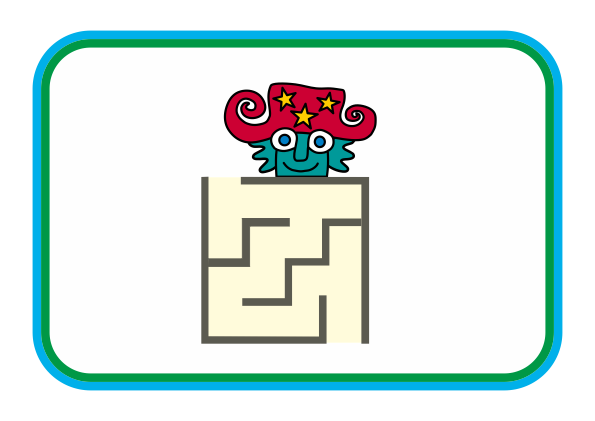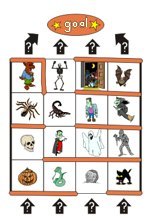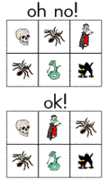
The man who knows how to split the atom but has no love in his heart becomes a monster.
Krishnamurti (1895-1986)
Education and the Significance of Life
Maze Challenge

words
path
challenge
Aim
Players attempt to navigate an invisible maze. Can they make it out within the time limit? The example given here uses Halloween vocabulary but the idea is not limited to Halloween. You need two copies of a sheet per game. It's a good idea to laminate sheets and put them into plastic sleeves during play. This way marker pens can be used and sheets used more than once.
Preparation
Give the players a sheet and spend a little time going through the vocabulary. Then take a sheet and draw a maze by making walls using the squares. The maze should have an exit at the top and an entrance at the bottom. Any design that allows players to visit every square is legitimate. Give the players a pen and a counter, set the time limit and start the clock.
Method of Play

Starting at the bottom the players try to trace a path through the maze. Players may move up or down but not diagonally. In turn each player names one item. If the move is legitimate say ”OK”. The players move the counter to that square. But if the players attempt to move through a wall call out “Wall”. Players draw in the wall and move the counter back to the start. This is key. Every time the players hit a wall they must start over from the beginning.
Example Maze: With four players, play may go as follows) Player One: “Gravestone” (OK), Player Two: “Ghost” (Wall! Start again!). Player Three: “Gravestone” (OK), Player Four: “Black Cat” (OK), Player One: “Mummy” ((Wall! Start again!).
Variations
Rather than using a pen to draw walls and a counter players could attempt to navigate the maze through memory alone.
The challenge can be increased by having students make a sentence using a word rather than simply naming it. An even greater challenge is to stipulate that the same sentence cannot be used more than once. Of course, if the students are making sentences the time limit should be adjusted.
When the time limit goes players should be allowed to keep going until they hit a wall. In this way there is a chance that they can escape right at the end.
If the maze design is difficult (usually one where players are required to go backwards) players can be given a hint. For the example above you could say, "Sting those bones!" or "Don't' go trick-or-treating".
Notes
When introducing the game it is usually best to start with a simple maze with more than one way to get out. When players are familiar the teacher can ask whether the players want an easy, medium or difficult maze and design one accordingly.
When players hit a wall make a sound effect for the process of returning to the start. Mimicking the sound of a dying Pacman can work well. A little humour can soften the blow of having to start again and even increase the players' motivation to get through the maze.
When using the game with large classes players can divide into teams. Each team can have a copy of the sheet but take turns calling out words or sentences. Alternatively, players could work in pairs or small groups and take turns designing mazes for each other. Just make sure players are drawing legitimate mazes. A good option is to limit a design to 6 outer walls and 6 inner ones.
Maze Design

A blank template is provided to download. The Halloween example also uses 16 different vocabulary items. It is possible to repeat items which may work better from the point of view of re-enforcing vocabulary. However, if an item is used more than once be careful to make sure that the items are kept apart. Be wary of creating a confusing board where the same item can be moved to twice from one square. See the diagram opposite - in the top example there is a problem moving to a spider from the skull - which spider? The bottom example doesn't have this problem.
getfile: Maze Challenge
Maze Challenge Blank TemplatePDF File A4, 2 pages, 39 kb Months and Seasons
PDF File A4, 2 pages, 1.78 mb
- Top Page
- Splog!
- Articles
- Games
- Across The Table
- Add One More
- Anaconda
- Be A Monster!
- Black Hole (board game)
- Bombs Away!
- Catch!
- Catch-Caught-Caught!
- Centipede
- Charades
- Co-operative Quiz
- Crocodile
- Dice Stack
- Fast Food Tag
- Find My Number
- Find The Penny
- Football
- The Happy Game
- Line Up!
- Maze Challenge
- Natty Narration
- Nose Nose Nose
- One Step Forward!
- Pair Fluency Match 7 - Death Wish
- Pair Fluency Match 7 - Go Green!
- Parrot Parade
- Passport Control
- Reach The Top!
- Snake
- SockIt!
- Tickle Time
- What Cards
- Which One?
- Whose Shoe?
- World Cup Football 2018
- You, You, Me!
- Wake Up
- Packs
- Sheets
- Songs and Music
- Strips (songs and otherwise)
- Stories
- Techniques
- Video
- Environment
- Japan
- The 75th Anniversay of the bombing of Hiroshima
- The 75th Anniversay of the bombing of Nagasaki
- Cars in Japan
- Coronavirus Olympics
- Forest Bathing
- Japan and the Summit
- Japan and World War Two
- Multiculural Japan?
- Olympics Two Tokyos
- Plastic in Japan
- Return to Fukushima
- The Anniversary too Important to Cancel
- Typhoon Jebi
- Yayoi Kusama's Infinity
- Other
- This Week In History
- January, February, March
- April, May, June
- Sub Menu Item
- This Week in History: April 8-10
- This Week in History: April 12-15
- This Week in History: April 19-24
- This Week in History: April 24-26
- This Week in History: May 6-11
- This Week in History: May 11-14
- This Week in History: May 18-23
- This Week in History: May 25-31
- This Week in History: June 1-5
- This Week in History: June 11-14
- This Week in History: June 22-27
- This Week in History: June 15-21
- This Week in History: June 29 - July 5
- July, August, September
- This Week in History: July 6-12
- Sub Menu Item
- This Week in History: July 14-19
- This Week in History: July 27-31
- This Week in History: August 2- 6
- This Week in History: August 17-21
- This Week in History: August 27-30
- This Week in History: August 31 - September 6th
- This Week in History: September 7-13
- This Week in History: September 22-27
- This Week in History: September 14-20
- This Week in History: September 28 - October 4
- October, November, December
- Quizes
- Vocab



